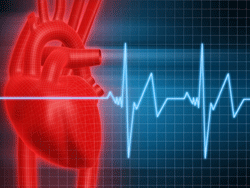What causes irregular heart beat? – Learn about heart disease.
 Here’s another question I asked Dr. Cynthia Shelby-Lane and her answer about causes irregular heart beat.
Here’s another question I asked Dr. Cynthia Shelby-Lane and her answer about causes irregular heart beat.
Lisa Nelson: What do you recommend for individuals experiencing heart palpitations and what may be triggering the problem?
Dr. Shelby-Lane: Arrhythmias are any deviations in the normal rhythm of the heart (heartbeat). They usually occur as a result of interference with the electrical pathways that produce the heart’s rhythmic muscular contractions. The Parasympathetic Nervous System is responsible for slowing down the heartbeat rate. The Beta-1 Adrenergic Receptors of the Beta-Adrenergic Nervous System are responsible for speeding up the heartbeat rate.
If you experience the following symptoms, you may need to be evaluated for toxicity and consider a stress test, echocardiogram, holter monitor or a tilt table test for further evaluation and diagnosis. A neurologic evaluation may also be indicated.
Fluttering or pounding in the heart
Hemodynamic disturbances are potentially life-threatening such as bradycardia and tachycardia
Dizziness
Syncope (fainting)
Unusual awareness of the heart
Anxiety
Abnormal ECG (provides a “one-shot” picture of the electrical activity of the heart)
Holter 24-hour monitoring results (Holter monitors look at the heart for a longer period of time and are necessary to detect intermittent rhythm problems.
Possible Causes Irregular Heart Beat, Contributing or Associated Factors
1. Coronary artery disease
2. Hypertension
3. Adverse drug reactions
4. Endocrine imbalances, especially thyroid or adrenal disorders
5. Myocardial tissue disease (valvular, atrial and ventricular abnormalities)
6. Sequela of rheumatic fever
7. Metabolic disorders
8. Nutritional deficiencies, especially magnesium
9. Caffeine
10. Environmental toxins or food allergies
11. Damaged conductive tissue (neurocardiogenic syncope)
12. toxicities
13. anxiety and stress disorders, etc.
Follow up diagnostic testing is recommended to determine if the above conditions are causing the problem.
Heart disturbances can occur as a symptom of magnesium deficiency: Measuring your red blood cell magnesium can give you a good idea of your actual magnesium level.
All the best,
Lisa Nelson RD
Heart Healthy Tips
Lose Weight by Eating Breakfast
You’ve heard it before and you’ll hear it again – breakfast is the most important meal of the day. There’s just no way around it.
I frequently hear “I don’t have time for breakfast” and “I’m not hungry in the morning”, neither reason negates the importance of eating breakfast every morning. Maybe it’ll be easier to make breakfast a priority if you understand why it’s so important.
First, breakfast occurs after about an 8 hour fast (think how many hours are between your last meal of the day and breakfast). When you wake up in the morning, your blood sugar and glycogen stores (carbohydrates stored in your muscles and liver) are depleted and the body is searching for fuel. If you don’t feed your body it goes into conservation mode, drops your metabolism (the rate at which you burn calories throughout the day), preserves your fat stores (the body is thinking “starvation”), and will turn to muscle for the energy it seeks.
Second, when you skip breakfast you’ll frequently grab snacks mid-morning to tide you over until lunch. Usually, the snacks that tempt you are high in fat, sugar, and calories. A breakfast that includes a balance of protein, carbohydrates, and fiber reduces these mid-morning cravings.
What’s Going on Physically
Your body is primed and ready to go in the morning. Your metabolism is boosted and your hormones cortisol, adrenaline, and serotonin are highest first thing in the morning.
Cortisol
This hormone promotes the breakdown of lipids (fancy name for fats) which is a good thing; however, it also promotes the breakdown of muscle. It blocks muscle from taking in more amino acids (muscle building blocks) and inhibits new muscle formation.
Adrenaline
Your fight or flight hormone increases your blood sugar to give your body immediate energy by breaking down glycogen in the liver and mobilizing amino acids stored in muscles. However, I’ve already stated that by the time morning rolls around, your glycogen levels are depleted. This means there’s not a reserve glycogen supply and muscle receives adrenalines full attention for the fuel it’s after.
Serotonin
Just to throw an extra hurdle into your morning routine, serotonin is at peak levels first thing in the morning. Serotonin reduces your appetite. There’s a reason you don’t feel hungry!
Research Support
A recent weight loss study reinforces the importance of breakfast. Two groups of women were compared. The first group followed a low calorie diet (1200 calories) that included a balanced protein/carbohydrate intake. This first group ate 50% of their daily calories in the morning (600 calories). The second group followed a low calorie (1000 calories), low carbohydrate diet and ate 25% of their calories in the morning. The first group lost ~40 pounds over 6 months, while the second group lost ~10 pounds (28 pounds first 4 months, followed by 18 pound regain). These results support the fact that a substantial, well-balanced breakfast is essential for long-term weight loss success.
Quick and Easy Breakfast Lose Weight Ideas
What can you do if breakfast doesn’t appeal to you? If you’ve been skipping breakfast for years, changing your habits will be hard, but not impossible. Take it slow and add something small working your way up to a good breakfast with a balance of carbohydrates and protein.
Here are some examples of quick and easy breakfast meals that include a balance of protein and carbohydrates.
Whole wheat toast with peanut butter
Low fat cottage cheese with canned peaches (light syrup)
Banana with handful of mixed nuts
Whole grain cereal with low fat milk
Apple with hard-boiled egg
Low fat yogurt with granola
By eating a well-balanced breakfast you provide your body the fuel it needs, protect your muscles, boost your metabolism, and reduce cravings throughout the day.
February is American Heart Month. In recognition of American Heart Month you can access Heart Health Made Easy at a 25% savings. Learn more about this take action guide to lower cholesterol and blood pressure at http://www.hearthealthmadeeasy.com.
All the best,
Lisa Nelson RD
Heart Health – Are you getting enough potassium?
If you have high blood pressure or want to take steps to prevent high blood pressure, it’s very important you balance your intake of sodium and potassium. The more potassium in your diet and the lower the sodium, the better your blood pressure will be.
The typical American diet contains 3.6 grams of sodium daily, while the current guidelines recommend limiting sodium to 2.3 grams or less daily (~1 teaspoon). Many Americans are deficient on potassium intake with various causes of low potassium. Currently dietary guidelines recommend 4.7 grams of potassium each day. Good potassium sources include bananas, potatoes, cantaloupe, dates, nuts, oranges, and green leafy vegetables.
All the best,
Lisa Nelson RD
7 Natural Ways to Lower Blood Pressure
A Blood Pressure Drop as Temperatures Rise?
More interesting research findings I want to share.
A French study found a link between the weather and blood pressure, especially for individuals over the age of 80. As temperatures dropped 25 degrees, such as change from summer to winter, systolic blood pressure (top number) increased 5.0 mmHg.
Hmmm, another reason to retire in the tropics!
All the best,
Lisa Nelson RD
7 Natural Ways to Lower Blood Pressure
Increase Physical Activity – How to increase physical activity and improve heart health
You want to be more physically active, but how do you find the time? And just how much activity do you have to do?
The number one reason people are not more active is time. We now know that accumulating short bouts of activity throughout the day to reach a total of 30 minutes most days a week provides comparable benefits to completing 30 minutes of activity all at once. There are many ways to increase your physical activity level by simply putting a twist on activities you already complete daily.
Here are some examples of how to boost your fitness when at home and work.
Home
Nothing beats increasing physical activity at home. No time wasted traveling to a gym and you can wear and look however you want! Many typical home activities result in an increased heart rate and strength building. Some examples include mowing/raking the lawn, shoveling snow, vacuuming, mopping, unloading the car, carrying groceries, and taking out the trash. Now take these everyday activities and add a little something extra. How about lunges while you vacuum, arm curls while carry your grocery bags, calf raises while brushing your teeth, and actually squatting when accessing bottom shelves? Do you log more hours than you care to admit in front of the TV? Take advantage of the commercial breaks to do 3 minutes of sit-ups or push-ups.
At the Office
Start your day by arriving at work a few minutes early so you have time to park your car farther away or if you take the bus, get off early and walk the last couple blocks. This is a simple way to add 10-15 minutes of activity to your day while also giving you some much needed time to yourself. Opt for the stairs instead of the elevator to reach your office. Be sure to take two 15 minute breaks during an eight hour work day. Use your break time to boost your fitness level by stretching or taking a walk around the building. If time gets away from you, schedule your computer to provide a “break time” reminder. Short breaks for activity throughout your work day have the added benefit of clearing your mind, boosting your energy, and making your work time more productive. Other ways to increase your activity level at work include finding a longer route to the bathroom or coffee machine and walking to a co-workers office versus reaching for the phone. A pedometer is a great tool for monitoring your activity when at the office. You can set goals to try to increase the number of steps you walk each day to improve your fitness level.
Achieving your fitness goals does not require a fancy gym membership or expensive exercise machine. A little creativity goes a long ways. Don’t miss part 2, which will include tips to boost activity when traveling, running errands, and caring for children.
Read part 2 with tips to boost physical activity here.
If you want regular support achieving your fitness and health goals, subscribe to The Heart of Health today! Now get off the couch and get moving!
Heart Health – Are Omega 6's Good or Bad?
I and other experts so frequently discuss omega 3 fatty acids and the health benefits that you may think all other types of fat are “bad”. That’s not the case. There are many types of heart healthy fats, including omega 6 fatty acids. At least 5-10% of your daily calories should come from omega 6 fatty acids. Some sources of omega 6’s are safflower, sunflower, and soybean oils. Replacing unhealthy fats in your diet with heart healthy unsaturated fats (such as omega 6’s) can decreased coronary heart disease by 24%.
The problem comes from our diets containing too much omega 6. The typical American diet is very high in omega 6 fatty acids. This leads to problems with inflammation when the ratio of omega 3 to omega 6 intake is drastically distorted and is why you don’t hear experts recommending you increase omega 6’s in your diet. You probably have more than enough already and need to work on balancing your omega 6’s with omega 3’s to promote optimal heart health.
February is American Heart Month. In recognition of American Heart Month you can access Heart Health Made Easy at a 25% savings. Learn more about this take action guide to lower cholesterol and blood pressure at http://www.hearthealthmadeeasy.com.
All the best,
Lisa Nelson RD
Be Heart Healthy and Lose Weight



